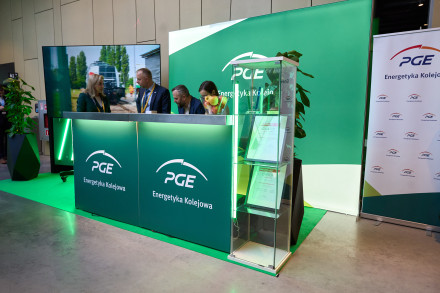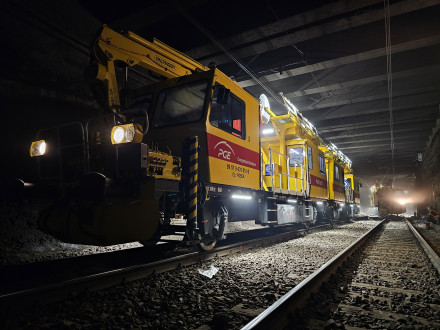PKP Energetyka joined the Policy Council of the Polish Energy Storage Association
05.05.2022, 10min read

PKP Energetyka became a member of the Polish Energy Storage Association. Leszek Hołda, a Member of its Management Board became a Member of the PESA Policy Council, bringing in knowledge and practical experience. PKP Energetyka has actually built the biggest railway traction energy storage facility in Europe. The company is also constructing a hydrogen-based energy storage system. It will be a first of this kind solution in Poland dedicated to the railway power supply. Experience gained during these projects will doubtlessly be of support to the members of PESA and everyone interested in energy storage technology.
PKP Energetyka became a member of the Polish Energy Storage Association. Leszek Hołda, a Member of its Management Board became a Member of the PESA Policy Council, bringing in knowledge and practical experience. PKP Energetyka has actually built the biggest railway traction energy storage facility in Europe. The company is also constructing a hydrogen-based energy storage system. It will be a first of this kind solution in Poland dedicated to the railway power supply. Experience gained during these projects will doubtlessly be of support to the members of PESA and everyone interested in energy storage technology.
One of the objectives of PESA is to integrate the communities dealing with the generation and distribution of green energy. – The more members with diverse competencies will join our ranks, the greater the opportunities to popularise green energy and to use it in various sectors of the economy, – said Barbara Adamska, President of the Management Board of the Polish Energy Storage Association. – Energy storage can be used by businesses in various industries, providing them with both savings and security of supply. We are pleased with the decision by PKP Energetyka to join PESA. They are the leader in using energy storage in the railway industry on the European scale. For the current and the future members of our Association, it is an example of how to efficiently distribute energy obtained from nature on a huge scale, – added the PESA’s president.
PKP Energetyka is one of the biggest electricity companies in Poland. It connects the railways with the National Electricity System. It is responsible for the reliability and quality of power supply for rail transport. For several years, PKP Energetyka has been consistently implementing cutting edge technological solutions to improve the quality, safety and efficiency of its operations. Today, PKP Energetyka is an innovative company that meets global standards, is based on digitalisation, sustainable development and employees committed to its growth. The company is the coordinator of the Green Railway® strategic programme followed by the railway industry players associated with the Center for Railway Energy Efficiency aimed at transforming the railway sector’s energy mix to 85% of clean renewable energy. One of the cornerstones of the Programme is the development of a network of energy storage facilities, including hydrogen-based units.
The involvement of PKP Energetyka in the activities of PESA’s Policy Council demonstrates its openness to collaboration, drawing on the experiences of others and ability to share its practical knowledge. – The energy transformation requires innovative and coordinated activities focused on the growth of the Polish energy storage market. This is why we have joined the activities of PESA, which is known for its substantive study papers, looking for synergies and promoting green solutions. We will gladly share our experience in rail transport that is the backbone of electromobility and will draw on the experience of other partners of the Association, – pointed out Leszek Hołda, Member of the Management Board of PKP Energetyka.
Energy transformation of the railway industry is inevitable. One of its important elements is the local generation, storage and distribution of electricity produced from renewable sources. The 2030 Strategy followed by PKP Energetyka assumes, among other things, gaining the maximum possible independence from the geopolitical situation, increasing the operational security in the regions and minimising CO2 emissions. Among others, this will be made possible with the energy storage facilities. Last year, PKP Energetyka has commissioned Europe’s biggest traction energy storage unit located in the vicinity of a traction substation in Garbce (Lower Silesian region). The company is planning to ultimately construct 300 storage units in its network. Every storage facility is the “heart” of the Local Balancing Area, a microgrid integrated with the railway power supply system and the regional customers. The next step in this segment will be the use of hydrogen. The solution’s concept was developed jointly by the experts from PKP Energetyka led by Professor Grzegorz Benysek. It provides for a hydrogen section to work with the photovoltaic installation being built next to the traction substation in Garbce. Its main job will be to produce, store and combust green hydrogen. Hydrogen solutions will be an additional component of the Garbce traction substation that together with the existing traction energy storage facility and the photovoltaic farm will create a true “substation of the future”. The hydrogen produced will be 100 per cent green – it will be obtained through a process of electrolysis powered by energy provided by the Sun. – Thanks to the use by PKP Energetyka of energy storage facilities, travelling with no carbon footprint is becoming possible now and here. Already today the Łódź Suburban Railway runs on green power in 30 per cent and by 2028 the customers of this carrier will be travelling with no carbon footprint at all. This perspective is not only possible but actually crucial to all businesses. We want this example to stimulate others, – said B. Adamska.
– Energy storage facilities improve railway power supply security and quality and balance the power taken off the National Electricity System. The facility in Garbce flattens out the peak loads on the nearby traction substation and its supplying distribution network, allowing a reduction of the contracted capacity by even up to 60%. The use of storage allows also reducing transmission losses by around 63%. This is also important in the context of supply security and the need to make Poland independent from coal from the East, which today constitutes 7% of Poland’s energy mix. By 2030, Polish railways will be powered by solar and wind energy, and this will significantly improve Poland’s energy supply security, – added L. Hołda.






